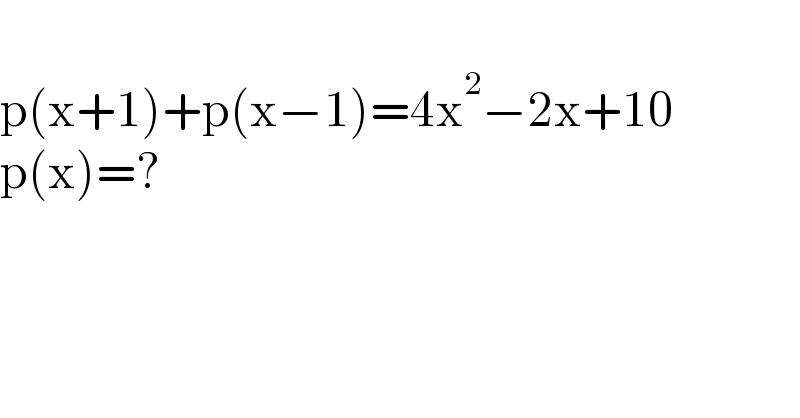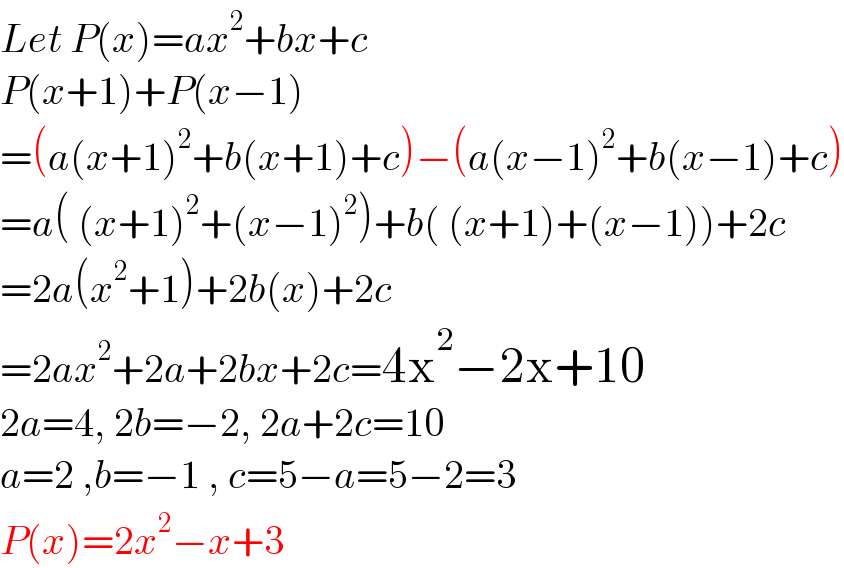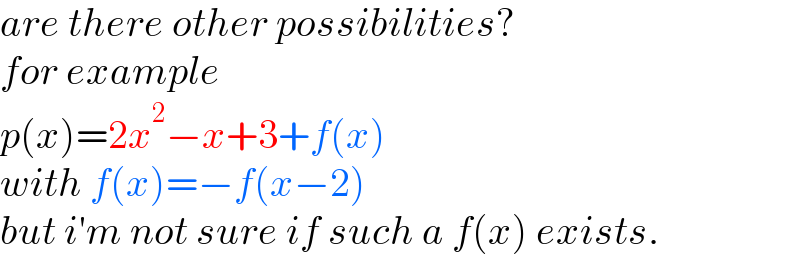
Question Number 198850 by mustafazaheen last updated on 25/Oct/23

$$ \\ $$$$\mathrm{p}\left(\mathrm{x}+\mathrm{1}\right)+\mathrm{p}\left(\mathrm{x}−\mathrm{1}\right)=\mathrm{4x}^{\mathrm{2}} −\mathrm{2x}+\mathrm{10} \\ $$$$\mathrm{p}\left(\mathrm{x}\right)=? \\ $$$$ \\ $$$$ \\ $$
Answered by Rasheed.Sindhi last updated on 25/Oct/23

$${Let}\:{P}\left({x}\right)={ax}^{\mathrm{2}} +{bx}+{c} \\ $$$${P}\left({x}+\mathrm{1}\right)+{P}\left({x}−\mathrm{1}\right) \\ $$$$=\left({a}\left({x}+\mathrm{1}\right)^{\mathrm{2}} +{b}\left({x}+\mathrm{1}\right)+{c}\right)−\left({a}\left({x}−\mathrm{1}\right)^{\mathrm{2}} +{b}\left({x}−\mathrm{1}\right)+{c}\right) \\ $$$$={a}\left(\:\left({x}+\mathrm{1}\right)^{\mathrm{2}} +\left({x}−\mathrm{1}\right)^{\mathrm{2}} \right)+{b}\left(\:\left({x}+\mathrm{1}\right)+\left({x}−\mathrm{1}\right)\right)+\mathrm{2}{c} \\ $$$$=\mathrm{2}{a}\left({x}^{\mathrm{2}} +\mathrm{1}\right)+\mathrm{2}{b}\left({x}\right)+\mathrm{2}{c} \\ $$$$=\mathrm{2}{ax}^{\mathrm{2}} +\mathrm{2}{a}+\mathrm{2}{bx}+\mathrm{2}{c}=\mathrm{4x}^{\mathrm{2}} −\mathrm{2x}+\mathrm{10} \\ $$$$\mathrm{2}{a}=\mathrm{4},\:\mathrm{2}{b}=−\mathrm{2},\:\mathrm{2}{a}+\mathrm{2}{c}=\mathrm{10} \\ $$$${a}=\mathrm{2}\:,{b}=−\mathrm{1}\:,\:{c}=\mathrm{5}−{a}=\mathrm{5}−\mathrm{2}=\mathrm{3} \\ $$$${P}\left({x}\right)=\mathrm{2}{x}^{\mathrm{2}} −{x}+\mathrm{3} \\ $$
Commented by mr W last updated on 25/Oct/23

$${are}\:{there}\:{other}\:{possibilities}?\: \\ $$$${for}\:{example} \\ $$$${p}\left({x}\right)=\mathrm{2}{x}^{\mathrm{2}} −{x}+\mathrm{3}+{f}\left({x}\right) \\ $$$${with}\:{f}\left({x}\right)=−{f}\left({x}−\mathrm{2}\right) \\ $$$${but}\:{i}'{m}\:{not}\:{sure}\:{if}\:{such}\:{a}\:{f}\left({x}\right)\:{exists}. \\ $$
Commented by mr W last updated on 25/Oct/23

$${great}! \\ $$$${that}\:{means}\: \\ $$$${p}\left({x}\right)=\mathrm{2}{x}^{\mathrm{2}} −{x}+\mathrm{3}+{k}\:\mathrm{sin}\:\frac{\left(\mathrm{2}{n}+\mathrm{1}\right)\pi{x}}{\mathrm{2}} \\ $$$${is}\:{also}\:{a}\:{solution}. \\ $$
Commented by Rasheed.Sindhi last updated on 25/Oct/23

$$\:{I}'{m}\:{also}\:{not}\:{sure}\:\boldsymbol{{sir}}. \\ $$
Commented by Frix last updated on 25/Oct/23

$${f}\left({x}\right)=\mathrm{sin}\:\frac{\left(\mathrm{2}{n}+\mathrm{1}\right)\pi{x}}{\mathrm{2}} \\ $$
Commented by witcher3 last updated on 25/Oct/23

$$\mathrm{f}\left(\mathrm{x}\right)=−\mathrm{f}\left(\mathrm{x}−\mathrm{2}\right) \\ $$$$\mathrm{f}\left(\mathrm{x}−\mathrm{2}\right)=−\mathrm{f}\left(\mathrm{x}−\mathrm{4}\right)=−\mathrm{f}\left(\mathrm{x}\right) \\ $$$$\Rightarrow\mathrm{f}\left(\mathrm{y}\right)=\mathrm{f}\left(\mathrm{y}+\mathrm{4}\right),\mathrm{y}\:\mathrm{periodic}\:\mathrm{4} \\ $$$$\mathrm{sin}\left(\frac{\pi}{\mathrm{2}}\mathrm{x}\right) \\ $$$$\mathrm{sin}\left(\frac{\pi}{\mathrm{2}}\left(\mathrm{x}−\mathrm{2}\right)\right)=\mathrm{sin}\left(\frac{\pi\mathrm{x}}{\mathrm{2}}−\pi\right)=−\mathrm{sin}\left(\frac{\pi\mathrm{x}}{\mathrm{2}}\right)..\mathrm{worck} \\ $$
Commented by mr W last updated on 26/Oct/23

$${great}! \\ $$
